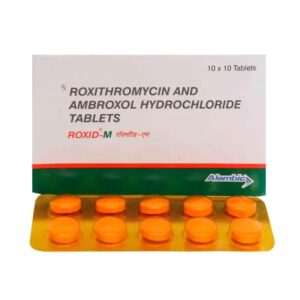ROXITHROMYCIN + AMBROXOL
Roxithromycin: Roxithromycin is an antibiotic medication belonging to the macrolide class. It is commonly used to treat various types of bacterial infections, including respiratory tract infections, skin and soft tissue infections, and urinary tract infections.
The mechanism of action of Roxithromycin involves inhibiting the growth and spread of bacteria. It works by binding to the 50S subunit of the bacterial ribosome, which prevents the synthesis of proteins essential for bacterial reproduction and survival.
The standard dose of Roxithromycin varies depending on the type and severity of the infection being treated. However, the usual adult dosage ranges from 150 mg to 300 mg taken once daily. It is important to follow the prescribed dosage and complete the full course of treatment to ensure effectiveness.
As with any medication, Roxithromycin may cause side effects. Common side effects include gastrointestinal issues such as nausea, vomiting, diarrhea, and abdominal pain. Less common side effects may include headache, dizziness, skin rashes, and allergic reactions. If any severe or persistent side effects occur, it is advisable to seek medical attention.
It is important to note that Roxithromycin may interact with certain medications, so it is essential to inform your healthcare provider about all other medications you are taking. It is also necessary to inform your doctor if you have any pre-existing medical conditions, such as liver or kidney problems, as this may affect the dosage or suitability of Roxithromycin for you.
Always consult with a healthcare professional for accurate and personalized information about the use, dosage, and potential side effects of Roxithromycin.
Ambroxol: Ambroxol is a drug primarily used as a mucolytic agent, which means it helps to thin and loosen mucus in the respiratory tract. It is commonly prescribed for conditions such as bronchitis, chronic obstructive pulmonary disease (COPD), and other respiratory tract disorders characterized by excessive and thickened secretions.
The main mechanism of action of Ambroxol is believed to involve increasing the production of pulmonary surfactant, which helps maintain the elasticity of the lungs and facilitate the clearance of mucus. It also promotes the movement of cilia in the respiratory tract, thereby aiding in the removal of mucus and improving the overall respiratory function.
Ambroxol is available in various forms, including oral tablets, syrups, and inhalation solutions. The dose may vary depending on the severity of the condition and the age of the patient. It is important to follow the prescribed dosage instructions provided by the healthcare professional or as mentioned on the product label.
Like any medication, Ambroxol can have potential side effects. The most common side effects include gastrointestinal disturbances such as nausea, vomiting, and stomach discomfort. Some individuals may also experience allergic reactions, skin rashes, or itching. These side effects are usually mild and transient. However, if any severe or persistent side effects occur, it is recommended to seek medical attention immediately.
It is important to note that individual responses to medications can vary, and it is always advisable to consult with a healthcare professional or pharmacist before starting or changing any medication regimen.

